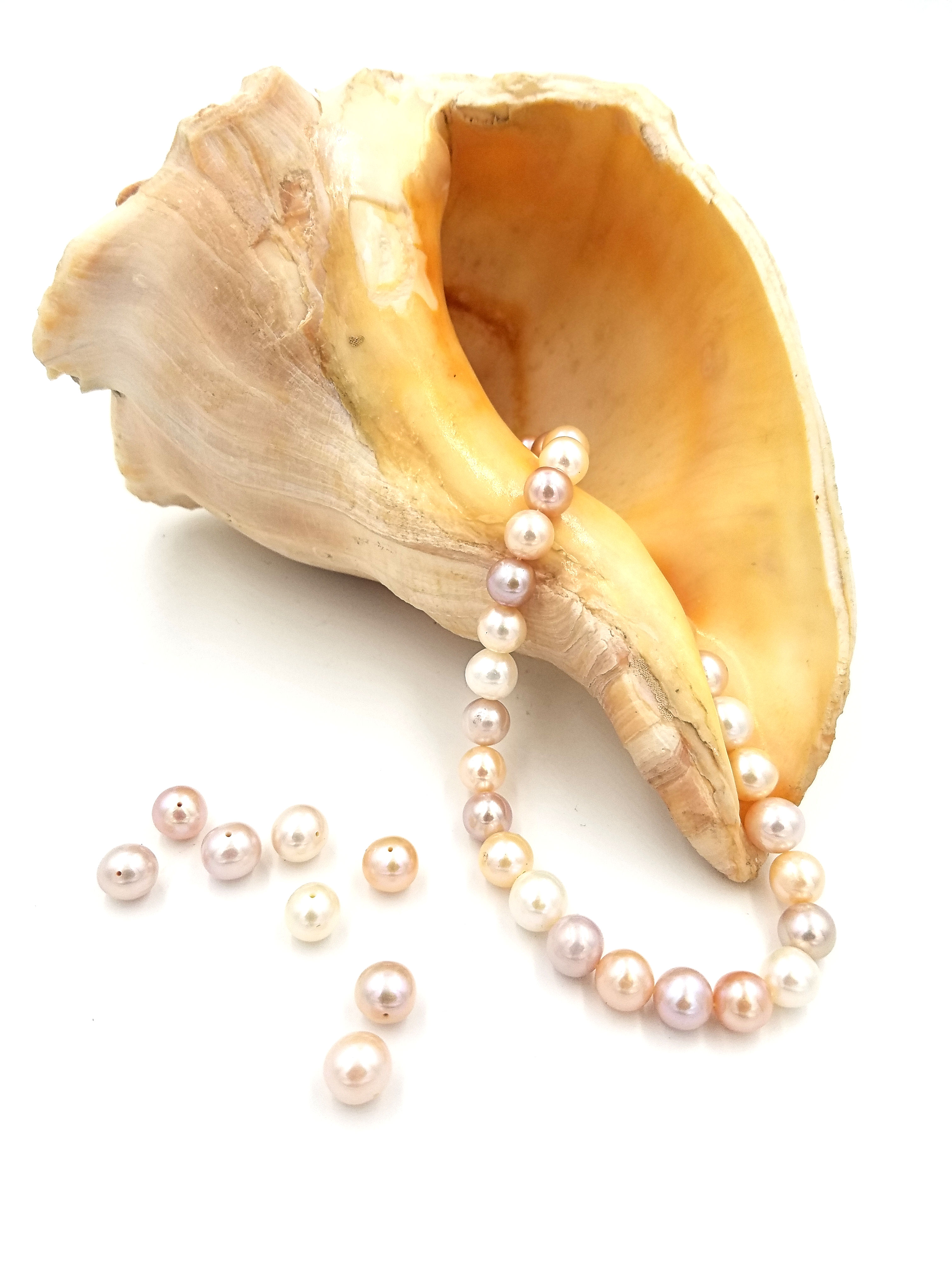Pearls have been regarded as one of the most valuable gem materials. They have been used for adornment for 6,000 years. This gem, a gift of the sea, has a myth and lore dating back to the beginning of time. A Hebrew legend says that pearls were the tears of Eve after being banished from the Garden of Eden. In America, it has been a long held tradition that a bride receives a strand of pearls as a bride's gift to wear on her wedding day.
Some Characteristics of Pearls
Pearls are produced by molluscs, rarely by snails. They consist of mother-of-pearl, which is mainly calcium carbonite (in the form of aragonite), and an organic horn substance (conchiolin) which are formed concentrically around microcrystals. They have a hardness of 3-4 on the Mohs scale.
Types of Pearls
-
Cultured Pearls
- Cultured pearls are not imitation but a natural product which has been produced with man's help. Today, cultured pearls amount to over 90% of the total pearl trade. Cultured pearls produce the finest pearls on the market today.
 Pearls are an organic gem material that grows in an oyster. When a piece of the mantle or beard of an oyster of an oyster is implanted into the heart of his mollusc, the material that forms around it is called nacre. Pearls are made up of layer upon layer of nacre. The longer these oysters are left in the water, the larger the pearl grows, until it reaches capacity for that particular type of oyster. Specific types of are used to grow specific types of pearls.
Pearls are an organic gem material that grows in an oyster. When a piece of the mantle or beard of an oyster of an oyster is implanted into the heart of his mollusc, the material that forms around it is called nacre. Pearls are made up of layer upon layer of nacre. The longer these oysters are left in the water, the larger the pearl grows, until it reaches capacity for that particular type of oyster. Specific types of are used to grow specific types of pearls.
-
Cultured Akoya OysterThe Akoya oyster produces pearls from 2.0 mm – 10.0 mm, usually spherical in shape. The usual color is white or cream in color, but pink and a deep rose pink are also achieved. Akoya pearls are usually bleached, dyed or tinted to improve their color. The most desirable shape is completely spherical.
-
Cultured South SeaSouth Sea Cultured Pears are grown in the world's largest oyster. The pearls grown in this oyster usually range from 9.0 mm – 18.0 mm or larger in size. Less than 1/3 of the productions of South Sea pearls are round; making these pearls very rare. White, light cream and gold are the most sought after colors of the South Sea Pearls. Silver, yellow, blue, and yellowish-orange are other colors available. South Sea Pearls are rarely dyed to improve their colors.
-
Cultured Tahitian PearlsTahitian cultured pearls are grown in the warm waters of French Polynesia. A particular oyster, the black-lipped oyster, is responsible for the exquisite size and color of Tahitian pearls. These pearls grow from 8.0 – 14.0 mm or larger with less than half of the pearls being spherical in shape. The most common shapes that are symmetrical but not round are oval and drops. Non-symmetrical baroque and semi-baroque shapes are also common. Tahitian pearls come in a glorious array of colors. These include black, gray, brown, green purple, and yellowish-green. Several colors are more highly valued. The most highly valued color is peacock a combination of dark green-gray or blue-gray with a rose or purple overtone. Aubergine is a very desirable grayish purple color. Yellowish-green or greenish yellow pearls are called pistachio, another excellent color that is also highly valued. Tahitian cultured pearls are rarely dyed to improve their color.
-
Freshwater Pearls
- Freshwater pearls are grown in mussels, not oysters. Their production has given us a wealth of new shapes like biwa, coin, button, etc. and every color of the rainbow. Many of these pearls are dyed to give us these vibrant colors. The production of freshwater pearls is very high, making the cost very affordable and providing a fun choice in jewelry.
Tips to Care for Pearls
Proper care of pearls is very important. The porosity of pearls is what enables them to be dyed. Never put pearls in an ultrasonic cleaner, water, soapy solutions or jewelry cleaner. Chemicals can also be absorbed into the nacre causing discoloration. A good rule for pearls is that they are the last thing you put on after you have applied perfume and/or hairspray and the first thing you take off.
